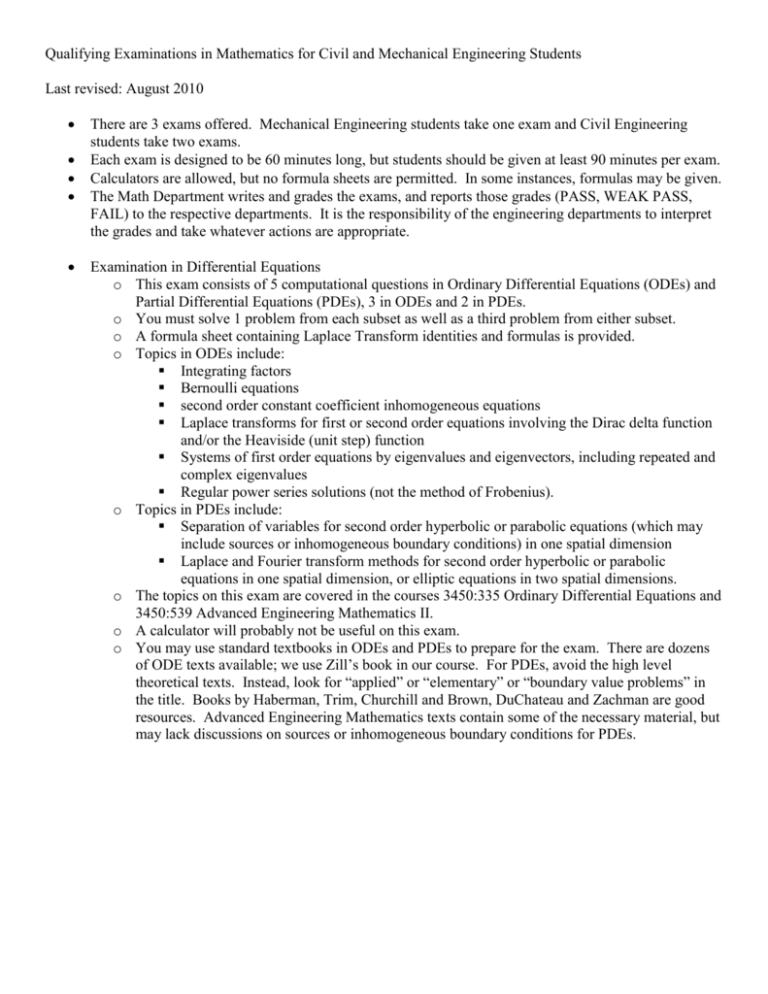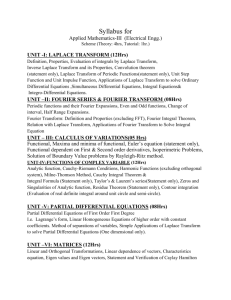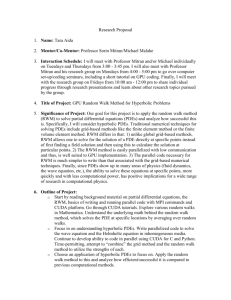Proposed Changes to the Mathematics Qualifying Examinations in
advertisement

Qualifying Examinations in Mathematics for Civil and Mechanical Engineering Students Last revised: August 2010 There are 3 exams offered. Mechanical Engineering students take one exam and Civil Engineering students take two exams. Each exam is designed to be 60 minutes long, but students should be given at least 90 minutes per exam. Calculators are allowed, but no formula sheets are permitted. In some instances, formulas may be given. The Math Department writes and grades the exams, and reports those grades (PASS, WEAK PASS, FAIL) to the respective departments. It is the responsibility of the engineering departments to interpret the grades and take whatever actions are appropriate. Examination in Differential Equations o This exam consists of 5 computational questions in Ordinary Differential Equations (ODEs) and Partial Differential Equations (PDEs), 3 in ODEs and 2 in PDEs. o You must solve 1 problem from each subset as well as a third problem from either subset. o A formula sheet containing Laplace Transform identities and formulas is provided. o Topics in ODEs include: Integrating factors Bernoulli equations second order constant coefficient inhomogeneous equations Laplace transforms for first or second order equations involving the Dirac delta function and/or the Heaviside (unit step) function Systems of first order equations by eigenvalues and eigenvectors, including repeated and complex eigenvalues Regular power series solutions (not the method of Frobenius). o Topics in PDEs include: Separation of variables for second order hyperbolic or parabolic equations (which may include sources or inhomogeneous boundary conditions) in one spatial dimension Laplace and Fourier transform methods for second order hyperbolic or parabolic equations in one spatial dimension, or elliptic equations in two spatial dimensions. o The topics on this exam are covered in the courses 3450:335 Ordinary Differential Equations and 3450:539 Advanced Engineering Mathematics II. o A calculator will probably not be useful on this exam. o You may use standard textbooks in ODEs and PDEs to prepare for the exam. There are dozens of ODE texts available; we use Zill’s book in our course. For PDEs, avoid the high level theoretical texts. Instead, look for “applied” or “elementary” or “boundary value problems” in the title. Books by Haberman, Trim, Churchill and Brown, DuChateau and Zachman are good resources. Advanced Engineering Mathematics texts contain some of the necessary material, but may lack discussions on sources or inhomogeneous boundary conditions for PDEs. Examination in Numerical Methods. o This exam consists of 5 computational problems in elementary numerical methods. You must solve 3 of the 5 problems. o No formula sheets will be provided. o A scientific calculator is necessary for this exam. o Topics include: Root finding for nonlinear equations via Newton’s Method Secant Method Bisection Method For these methods, be able to use the algorithm to do simple calculations, and understand the convergence properties of the methods Polynomial Interpolation and Splines Divided differences Lagrange Interpolation Error Theorem – estimate the maximum possible error of interpolation at a point or on an interval Hermite interpolation – build a Hermite interpolating polynomial using divided differences Natural Cubic Splines – build a spline using only 3 or 4 data points Quadrature (numerical integration) Newton-Cotes Rules – computation with the closed rules n=1,2,3,4 and error estimation for trapezoid and simpson rules Composite Trapezoid and Simpson Rules – computation with the rule, use of error formulas to estimate the number of subintervals required Gaussian Rules – computation with a given rule, and apply the change of interval formula Romberg Integration – computation by table given initial data Numerical Linear Algebra Gauss Elimination with partial pivoting, 3x3 Jacobi iteration, 3x3, put the matrix into diagonally dominant form and compute a few iterations Gauss-Seidel iteration, 3x3, compute a few iterations o Almost all of these topics are covered in 3450:527 Applied Numerical Methods I. o You may use standard textbooks in numerical analysis or numerical methods to prepare for the exam. We use Mathews and Fink in our course; Burden and Faires is another excellent resource. Examination in Analysis. o This exam consists of 5 problems that broadly fit under the title of ‘analysis’, although the problems are mainly computational in nature. You must solve 3 of the 5 problems. o There are 3 subtopics: Matrix Analysis (2 problems), Vector Calculus (2 problems), and Operational Methods (1 problem). You must solve one of the matrix analysis problems, one of the vector calculus problems, and one of the remaining problems. o A scientific calculator may be useful for this exam. o Topics include: Matrix Analysis Eigenvalues and eigenvectors of a matrix, 3x3 Diagonalization of a matrix, 3x3 Finding the nullspace of a matrix, 3x3 Finding the inverse of a 3x3 matrix Vector Calculus Find divergence and curl of a vector field Line integral computation Compute an integral using Green’s Theorem Compute an integral using Divergence Theorem Compute an integral using Stokes’ Theorem Operational Methods Bessel functions – given an equation in Bessel form, identify the solution Fourier Transforms – derive the transform of a convolution or derivative, or compute a transform directly for a simple function Laplace Transform – derive the transform of a convolution, derivative or eatf(t) Sturm-Liouville eigenfunctions – write the eigenfunction expansion of a 2 point boundary value problem o The topics Matrix Analysis and Vector Calculus are covered in 3450:538 Advanced Engineering Mathematics I; some Operational Methods material is covered in 3450:539 Advanced Engineering Mathematics II. o You may use any of the Advanced Engineering Mathematics texts (Kreyszig, Greenberg, Zill and Cullen, O’Neill) to prepare for this exam.







